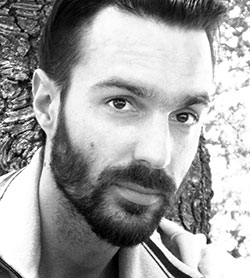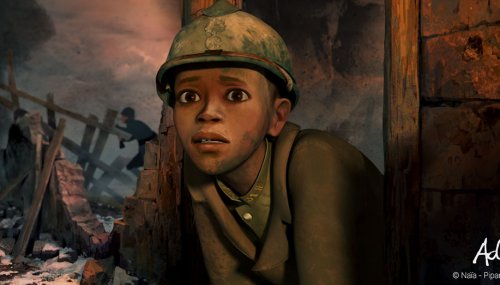Synopsis
We are in 1914. Adama, 12 year-old, lives in a remote village in West Africa, sheltered by the cliffs. Out, beyond, lies “the land of breaths”, the kingdom of wicked spirits hungry for war. When Samba, his elder brother, suddenly vanishes from the village, Adama decides to set off in search of him. Accompanied first by Abdou, a tragically lucid griot, then by Maximin, a street urchin who is his own negative twin, he crosses a Europe in the grip of war. Borne by the energy of desperation and the poetry of childhood, Adama travels to the hell of the frontline in order to free his brother and see his own initiatory journey through.
ADAMA
| Original Title | ADAMA |
| Category | Official Competition |
| Section | Elements +10 |
| Tipology | Animation, Feature Film |
| Duration | 82' |
| Nationality | France |
| Directed by | Simon Rouby |
| Screenplay | Julien Lilti, Simon Rouby |
| Script | Julien Lilti |
| Editor | Jean-Baptiste Alazard |
| Sound | Yan Volsy |
| Music | Pablo Pico |
| Original Voices |
Azize Diabaté (Adama) Oxmo Puccino (Djo) Pascal N’Zonzi (Abdou) Jack Amba (Samba) |
| Produced by | Philippe Aigle, Séverine Lathuilliere |
| Access |
|

Simon Rouby
Born 1980, Lyon (France). Ten years ago, he took his first artistic steps as a graffiti artist. Afterwards he accessed other mediums such as paintings and sculpture. From this background, he studied film directing first at the Gobelins School of the Image (Paris), then at the California Institute of the Arts - CalArts (Los Angeles). He directed the animated short films BLIND SPOT (2007), THE OMEN (LE PRÉSAGE, 2007), LA MARCHE (2010). ADAMA is his first animated feature film.
Director’s statement
“I grew up in a neighbourhood where the different communities mingled outside the buildings. I hung out with the Algerians, but they didn’t hang out with the Turks. My best friend had grown up in Madagascar. I played basketball with my Zairian classmates. We were divided into three categories: ‘French’, ‘Black’ and ‘Arab’. It all seemed perfectly normal to me.
“I understood later that not all neighbourhoods were like mine. When it was time for me to go high school, my parents faked an address so I could attend a more ‘suitable’ establishment and study Latin and German.
“I was out of step with two different worlds. On the one hand, I was the only guy in my class to listen to hip hop, be on first-name terms with the breakdancers outside the Paris Opera and hang out with the taggers of Mermoz-Pinel and Saint-Priest. But on the other, when the long arm of the law got too close for comfort because of the trains we’d painted, I was able, unlike them, to escape to art school.
“From there, ‘luck’ soon took me to Africa. I had the feeling someone had sent me there to make me understand how influenced I was by African culture, how much my favourite artistic movements were rooted in a song that had crossed the Atlantic and the Mediterranean, giving birth to gospel, to blues, to reggae and to rap before turning into explosions of paints on the walls of New York and then of my city.
“When I got back from my trip to Africa, I rediscovered my own world. In the subway, I could tell the difference between a Wolof and a Fulani, a Cameroonian accent and a West Indian. I became aware of the journeys these people, their parents or their grandparents had made to reach Europe. Ever since, I had the idea in the back of my mind to bring to the screen the shock of a man facing alone this complex, so-called modern world.
“This is the angle I have chosen for Adama’s journey. In the form of an initiatory tale, the film recounts his passage to adulthood and how he discovers his uniqueness, his identity but also what connects him to everyone else, his very humanity. It is the subjective exploration of our world by a child from ‘somewhere else’. A world that is at once sick and self-destructive yet also terribly beautiful and touching. Adama becomes capable of comparing the world he discovers with his own and, faced with this choice; he must assert his origins and become a man.
“It is this desire to recount Adama’s awakening that drove me for over five years to utilize all my resources to bring this project to fruition. I felt the deep need to show others this noble Africa no one ever told me about, to pay tribute to the men and women who have embarked on the long journey north over the years, in search of a better life, either as soldiers or workers.
“ADAMA is set in a specific period of history but it is not an historic film. For me, what is important is the contemporary resonance of Adama’s adventure.
“ADAMA is an adventure intended to be very subjective. Animation has the ability to connect audiences with a character’s innermost being, to make perceptible Adama’s changing view of the world around him. The screenplay enables us to see through his eyes a world undergoing the changes wrought by the First World War, and which eventually gave rise to today’s society.
“I see animation as a very rich language and have never wished to deprive myself of any of its vocabulary by choosing to make ‘a 2D film’, ‘a 3D film’, or a ‘painted film’. From 3D to painting to modelling, there is a huge range of graphic styles. Above all, I want the images to ring true, to vibrate with meaning.
“Freely combining different techniques has been a constant of my career thus far. Initially a spontaneous act, it has become a deliberate and conscious act, resulting in a singular style and a practical and efficient method of production. With this in mind, the common denominator is the real: observational drawing, travelogue, sculpture from models, 3D scanning and so on. It is always about capturing my environment. The faces are a perfect illustration of my approach: from the word go, I wanted to make the characters out of clay, to animate extremely rich yet imperfect and human faces. To model them, I turned to the studio of Michel Lauricella, a master and highly influential drawing teacher of mine. Since my student days, 3D scanning had become more accessible and widespread, and the sculpture studio a crossroads of old-school methods and cutting-edge technology: modelling in clay, plaster casts, laser scanning and photogrammetric reconstruction. This communion enabled me to bring my sculptures to the screen as they were then bring them to life while retaining the force of the material from which they were made. Such technical questions are crucial in animation as they result in decisions that shape the language used on screen. I always endeavour to find the best balance between simplicity of execution, whether through new techniques or traditional methods, and the greatest possible consistency between content and form.
“The core team was already in place: Alexis Liddell, Louis Tardivier, Pierre Ducos, Jeanne Irzenski, all graduates of Paris’ Gobelins school of applied arts, print and digital media, are versatile artists, totally involved in the project. More recently, Bénédicte Galup joined us as first assistant director. With her experience feature films, she helped us breathe new life into the script. In 2011, I directed a three-minute animation test, for which the team worked in the production conditions of a feature-length movie. This allowed us to test the effectiveness of our mixed-method approach in view of time and budget constraints. I was able to see whether my visual and narrative intents were realistic as regards the deadlines and financial resources for this film, which the producer and I always wanted to keep at a reasonable level. Despite its imperfections, this pilot represented a major step forward which led me to the film’s final graphic style.
“When making it, I contacted the artist Oxmo Puccino to ask him to be the voice of the character of Djo. This Malian-born musician, who moved to France at the same age as Adama, immediately made a rich contribution to the project, and our partnership has proved to be even more fruitful than anticipated. We have made use of the musicality of different French accents as the basis for the characters’ vocal identity: subtleties between countries of origin, Maximin’s outspokenness and so on. Oxmo also introduced me to cellist Vincent Ségal and kora player Ballaké Sissoko, whose ‘Chamber Music’ duet was already one of my main references for the movie’s theme, and they agreed to work on the project.
“As in all my previous films, I attach great importance to the atmosphere. I use it in my mise en scène to create an extra, almost subliminal, layer of rhythm: sound of footsteps, sound of wind, relationship between strident bird cries and whistling shells, percussion and explosions, whooshing sound of the cave heard again in the subway tunnel under construction. These sounds create meaning and enable Adama to find his bearings by looking as well as by listening. They are like so many omens guiding him on his initiatory journey, this non-traditional ritual he has to devise.
“When I write and devise the scenes of a film, the images come to me immediately, enveloped in sounds, impressions and emotions. When the time comes to make the film, I try to capture these mental images and transcribe them as faithfully as possible. Unfortunately, when I try to grasp them, they suddenly do not seem so tangible. Watercolour? Painting? Sculpture? Film? Drawing? What to do? How can they be transcribed? This is where the ‘technique’ comes into play. Initially an obstacle, it becomes an ally. To be as close as possible to these visual sensations, I proceed by elimination: I produce an image on paper, or the computer screen, and then compare it with what I am looking for. If need be, I alter or correct it. If it rings true, I continue on the same path. This is how the animation tests during the development phase enabled me to determine my aesthetic and narrative choices. But they also involved constant experimentation with different techniques. I was thus able to devise my production “pipeline”. In fact, this pipeline is a mixture, a combination of traditional elements, such as 2D animation and sculpture, and new technologies. This research phase enabled us to determine the full potential of these techniques, some of which have never previously been used in animation”.
production
Naïa Productions
--
Pipangaï
--
France 3 Cinéma
--
Albatros Productions
world sales
festival contact
Picture Tree International GmbH
Zur Börse 12, 10247 Berlin - Germany
phone +49 3042082480
mobile +49 15154458921
This email address is being protected from spambots. You need JavaScript enabled to view it.
This email address is being protected from spambots. You need JavaScript enabled to view it.
www.picturetree-international.com






